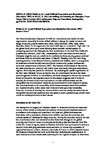Platform for Local Political Expression and Resolution (Barcelona 1992)
| dc.contributor.author | ESSEX, Stephen | |
| dc.contributor.editor | Bajc V | |
| dc.date.accessioned | 2016-03-24T09:36:06Z | |
| dc.date.available | 2016-03-24T09:36:06Z | |
| dc.date.issued | 2016 | |
| dc.identifier.isbn | 9780230289550 | |
| dc.identifier.other | 10 | |
| dc.identifier.uri | http://hdl.handle.net/10026.1/4413 | |
| dc.description.abstract |
The Barcelona Summer Olympics of 1992 are remembered as a model of urban regeneration, especially in terms of their ability to change the spatial structure and image of the city (Garcia-Ramon and Albet, 2000; Marshall, 1996, 2000, 2004; Monclús, 2003). To the organizers, the event itself was not considered “high risk.” At the global level, there were some thinking about possible reprisal attacks on competing nations in the Olympics for their involvement in the Gulf War (1990-91) (Coaffee and Johnston, 2007:146). Domestically, there was some concern that the Olympics might be used as a platform for publicity by those seeking greater political autonomy from the centralist state based in Madrid. Notably, there had been longstanding tensions in the Basque Country, Catalonia and Galicia, where a strong sense of social and cultural identity has underpinned demands for greater political and economic independence (Conversi, 1997). The location of the Games in Barcelona, the most populous and powerful city within these potentially divergent autonomous regions, obviously had particular resonance. By analysing the spatial organization of the four main Olympic venues across the city, the coordination between the multisectoral agencies involved in surveillance, and their strategies to counter any potential threat of disruption, the argument taken in this chapter suggests that in terms of security, the success of the event had more to do with political debate and the recognition that any disruption would be counterproductive to the respective causes. The principal threats to the tranquillity of the Games stemmed more from political and regional tensions within Spain than from externally-generated instability. However, in terms of security, the success of the event was partly determined by the recognition by potential dissidents that disruption to such a globally high-profile event would be counterproductive to their causes. | |
| dc.format.extent | 218-237 | |
| dc.language.iso | en | |
| dc.publisher | Palgrave Macmillan | |
| dc.relation.ispartof | Surveilling and Securing the Olympics: From Tokyo 1964 to London 2012 and beyond | |
| dc.title | Platform for Local Political Expression and Resolution (Barcelona 1992) | |
| dc.type | chapter | |
| plymouth.organisational-group | /Plymouth | |
| plymouth.organisational-group | /Plymouth/Faculty of Science and Engineering | |
| plymouth.organisational-group | /Plymouth/REF 2021 Researchers by UoA | |
| plymouth.organisational-group | /Plymouth/REF 2021 Researchers by UoA/UoA14 Geography and Environmental Studies | |
| plymouth.organisational-group | /Plymouth/Research Groups | |
| plymouth.organisational-group | /Plymouth/Research Groups/Centre for Research in Environment and Society (CeRES) | |
| plymouth.organisational-group | /Plymouth/Research Groups/Centre for Research in Environment and Society (CeRES)/CeRES (Reporting) | |
| plymouth.organisational-group | /Plymouth/Research Groups/Marine Institute | |
| plymouth.organisational-group | /Plymouth/Users by role | |
| plymouth.organisational-group | /Plymouth/Users by role/Academics | |
| dc.publisher.place | Basingstoke | |
| dc.rights.embargoperiod | Not known | |
| rioxxterms.licenseref.uri | http://www.rioxx.net/licenses/all-rights-reserved | |
| rioxxterms.type | Book chapter |


